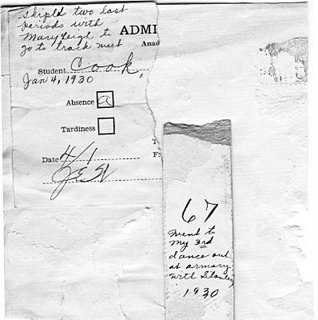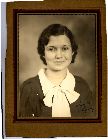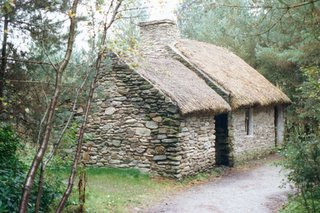Family Characters - James Daniel Hall
Do you have someone in your family who is a character? My Uncle Jim (James Daniel Hall 25 Feb 1901 Sumner County, KS - Jun 1978 Anadarko, Caddo County, OK) was truly a one-of-a-kind character who kept the family laughing for as long as I know about. I told someone recently that you could always tell when Jim was teasing - "When his mouth is moving."
In 1988 his sister Clara Belle Hall told me this story about an event that happened when they lived on the farm in
Another time, Aunt Clara was supposed to fix some lunch for Jim when he was working at the Vallier's filling station in Anadarko. She decided to take a nap and was asleep when Jim came home. He found a ball of twine and wrapped it around and under the bed so she couldn't get up - then went back to work.
Jim was one of the only Halls that seemed to carry part of the Scotch-Irish forward from our immigrant ancestor into our current life. He always insisted on planting potatoes on Saint Patrick's Day. Our friend, Homer Turney, from
Homer should have known better as Jim got him on another occasion just before Christmas. We asked Jim to bring some straw for a manger scene we were building at the office. Jim took a little left-over straw and put it into a nice bowl on the breakfast table along with a carton of milk. It was supposed to be a new cereal with 'lots of fiber' according to Jim. Homer had a bowl full of straw and milk before someone stopped him.
We built a lot fences with John Garland in Anadarko in the early 1970s and that experience provided a wealth of 'Uncle Jim' stories. He and my dad (William Stanley Hall 13 Mar 1912 Caddo County, OK - 4 Jan 2004 Olympia, WA) argued like children over the most trivial details of building fence. Jim's main complaint was that dad always seemed to be somewhere else when the work started, "Every time I look up that boy is either off taking a leak or going to town for more beer." Even in his 60s dad was a 'boy' to Uncle Jim. My dad was a stickler for details and wanted every post tamped in just so and almost insisted that we measure the distance between posts down to the inch. On the other hand, Jim was looking for easier ways to get things done. He pointed out that there was an old well up on the hill and that "we could get that old well, cut it into pieces and then just throw the pieces down from the back of the truck wherever we wanted a posthole." He had a fertile imagination. Just for the record, neither Jim nor Stanley got their way as John and I stepped off the holes and filled them quickly with the edge of our shoe.
We had a small tractor with an auger on the back to dig the corners of our fence and some of the rocky areas that were especially difficult. This provided one of the scariest moments of our fence-building time. Jim was driving and my dad was directing - back up, auger in gear, lower the auger, raise the auger, auger out of gear, drive forward. Sometimes it got a little monotonous and one or both of them would do the wrong thing. On this particular occasion Jim drove forward with the auger still in the ground. The front of the tractor reared straight up until the motor died with the tractor almost vertical. Jim was looking straight up into the sky and gasoline was dripping out of the tank right onto his lit cigarette. It was balanced and bouncing just a little bit forward and back and looked like it would go over backwards on the next bounce. As it bobbed forward, dad pushed the clutch just a bit so that it went forward a little further and kept doing that until it was back on the ground again. The argument started almost immediately, "You told me to drive forward." "No, when I do like this it means to raise the auger." John said later that he ". . . thought they were going to come to blows." The laughter this time one of those weird inappropriate raucous laughs driven by adrenaline and relief.
Jim loved children and all of the mothers in the family cringed at the things he taught the children. I remember him teaching me to make a corral out of a half slice of bread, "Tear out the middle part and put the crust up against the edge of your place. Then fill the corral with gravy and dip the bread in there." He also taught us how to dunk donuts and other unacceptable habits during that time. There was a nonsense rhyme that he taught some of the kids but, I never knew about it. My 2nd cousin Mark Thompson is perhaps the last person to learn it.
Everyone who knew him can tell a funny story about Uncle Jim. He liked to sit around with some friends behind West Hardware during the day. One of those friends came to Jim's funeral and I will never forget this grown man who reached into the casket and touched Jim for a long moment before moving on - a final tribute to Jim's ability to affect people around him.
You can review Jim's position in the family at my public site at . . .
http://www.familytrackers.com/myfamily.jsp?id=61








